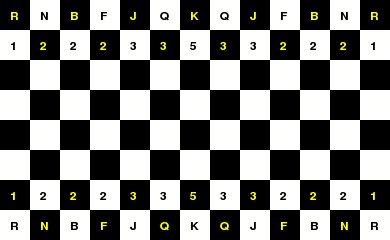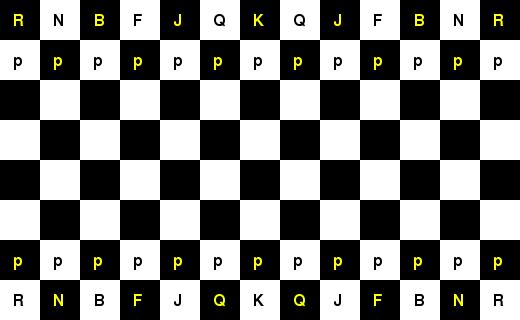PHI Chess
by Joshua Morris
Introduction
Phi Chess is a variant inspired by the golden ratio, Phi.
The idea was to create a Chess variant on a board shaped like a golden rectangle - long considered the most pleasing to human eyes - with the complete set of Chess pieces as envisioned by Henry Bird and Jose Capablanca.
Possible boards have ranks and files equal to consecutive Fibonacci Numbers:
- 2x1
- 3x2
- 5x3
- 8x5
- 13x8
- 21x13
- 34x21
- 55x34
- etc...
5x3 and below are pointless. Play Tic-Tac-Toe instead.
8x5 or 5x8 might be interesting for those who like small Chess variants.
21x13 and above are huge.
Setup
Phi Chess uses a 13x8 board with the following array (White is on the bottom):
Pieces
The Jack can move as a Rook or a Knight.
The Fool can move as a Bishop or a Knight.
All other pieces are as in Orthodox Chess.
(Note: in other variants, the Jack is called Marshall, Chancellor, or Empress; the Fool is called Cardinal, Archbishop, Princess, or Janus).
Rules
0. Phi Chess follows the rules of Orthodox Chess except as noted below.- Pawns have no initial two-step move or en passant capture.
- Pawns may promote to Rooks, Bishops, Knights, Fools, Jacks, or Queens.
- There is no rule for castling. The King begins in a strong position.
- There is no check or checkmate - the goal is to capture the enemy king. No advance warning is required. Unobservant or suicidal players may place their King under attack.
- Players are not required to move; they may pass. There is no stalemate. If both players pass twice in succession, the game is drawn by 3-fold repetition.
- If thirty moves pass without a pawn move or a capture, both players sum the values of all their remaining pieces and pawns. The player with the higher sum is the winner. In the case of a tie, the game is a draw.
- Bare King is a loss.
Piece Values:
| Unit | Value |
|---|---|
| Pawn | 1 |
| Knight | 3 |
| Bishop | 3 |
| Rook | 5 |
| Fool | 7 |
| Jack | 9 |
| Queen | 9 |
Notes
Cool things about Phi Chess:
The board is a golden rectangle.
The odd number of files means that the King sits directly in the middle. His minions, arrayed to the left and right, form a mirror image of pleasant symmetry.
The King sits on his own color.
The board has light and dark sides. On the light side, both the King's square and the corner squares are white; on the dark side, they are black.
Both Bishops are bound to the color of their army. This means that White is more powerful on white squares, Black is more powerful on black squares, and each army's Bishops can defend one another.
Each army has six pieces that move like Rooks, six that move like Knights, and six that move like Bishops.
All pawns are well-defended in the starting position, especially those in front of the King. The following diagram shows the number of times each pawn is defended:

Rules 5 and 6 above are intended to make Phi Chess less drawish than orthodox Chess. Time will tell whether these work well in practice. Perhaps a win in the thirty-move ending should count for less than a king capture (3/4 ?).
The piece values are rough estimates. It's not clear that a Fool is worth more than a Rook or that a Queen and a Jack are equal. No calculations were done for the new board. The values of orthodox pieces were stolen from orthodox Chess; the Fool and Jack values were determined, like the Queen's, by summing the values of their two sub-pieces and adding one to the total.
Playing Tips
Check your king, mate. There's no rule preventing him from moving into or staying under attack.
Watch out for Bishops fianchettoed on the b-file and the l-file. Both attack the King's pawn.
Put pawns on the enemy's color to deflect Bishops.
Without castling, there's no reason for flank pawns to remain static. Let the rooks come out to play.
Beware the Fool. Though weaker than the Queen or Jack, it has a power they lack: it can checkmate a cornered king without assistance.
Contact
joshua (at) anwu.org

